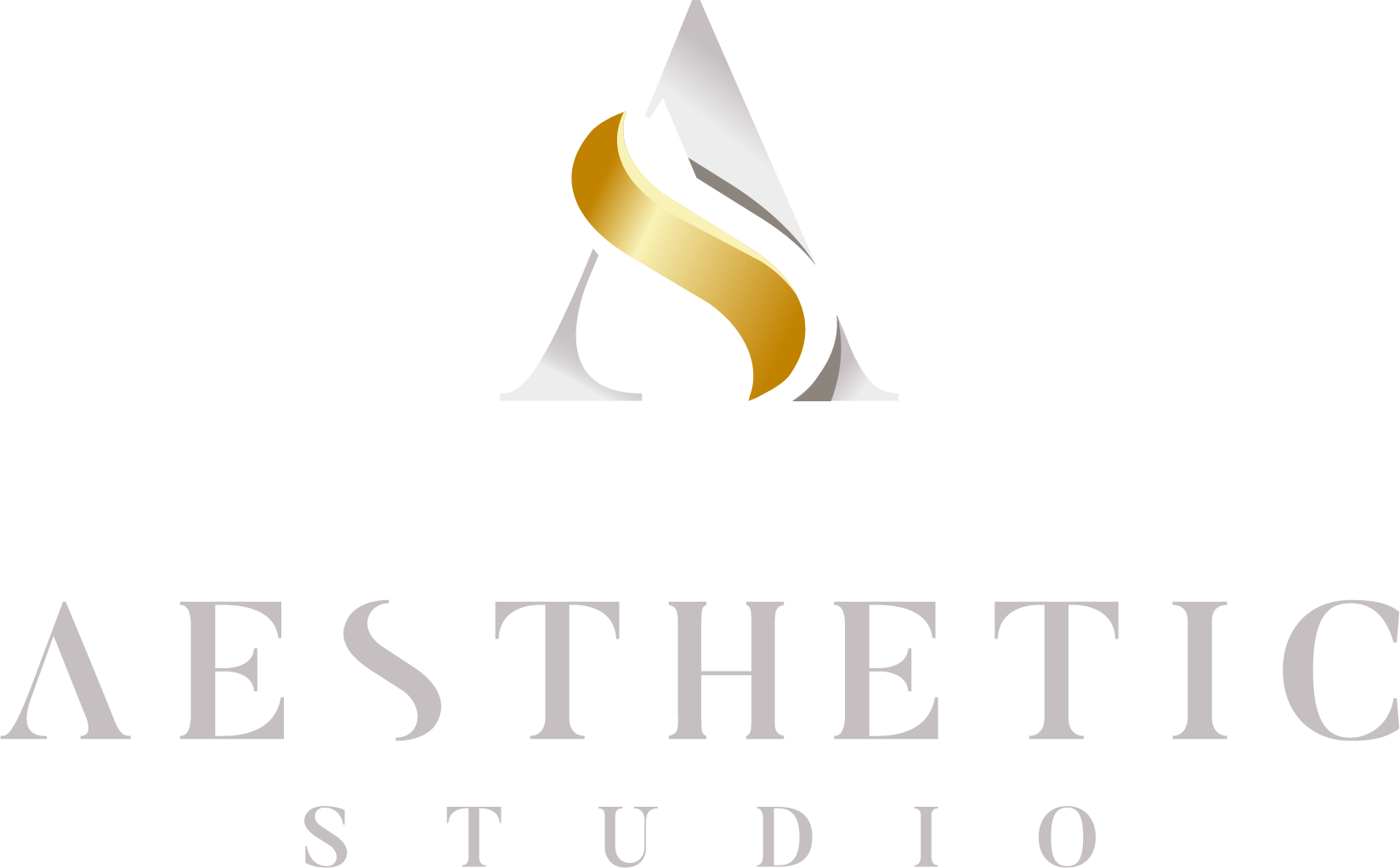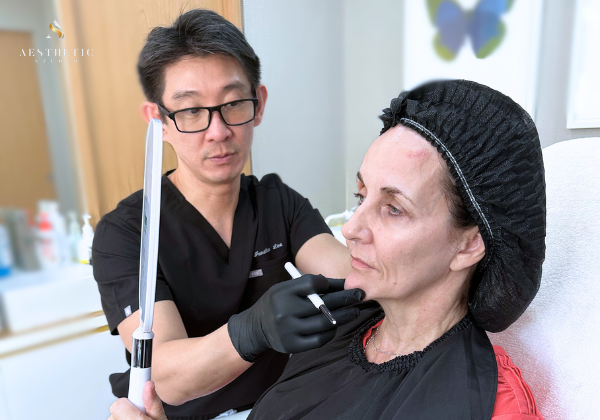Injectable Poly-L-lactic Acid (PLLA)
A regenerative collagen stimulator designed to restore what time depletes — from within
Poly-L-lactic acid (PLLA) is a clinically studied collagen biostimulator used in aesthetic treatments since 1999 globally. Unlike dermal fillers that simply replace lost volume by adding substance under the skin, PLLA works by stimulating your skin’s natural collagen production.
Over time, it support your skin’s own regenerative processes to address age-related volume loss, skin laxity, and improve overall skin texture — naturally and gradually — delivering long-lasting rejuvenation that evolves over months.
Key Benefits of Poly-L-lactic Acid
As poly-L-lactic acid (PLLA) works with your skin’s natural biology to stimulate collagen production, results appear natural and progressively — supporting a refreshed look without the risk of looking overdone. This regenerative approach makes PLLA ideal for:
Comprehensive Facial Rejuvenation: Effectively targets common signs of aging by rebuilding internal collagen support in multiple areas (e.g., temples, cheeks, nasolabial folds, and jawlines)
Volume Restoration: Replenishes lost volume in key areas (e.g., sunken cheeks, hollow temples, and deep folds) contributing to a more youthful contour
Improved Skin Quality: As collagen production increases, patients often notice improvements in skin texture, elasticity, and firmness
Natural, Lasting Effects: Unlike immediate-volume fillers, PLLA works gradually, so results appear more natural and harmonious — with effects lasting up to two years
Minimal Downtime: Most patients experience quick recovery and can return to normal activities shortly after treatment
Well-tolerated for Most Patients: Poly-L-lactic acid is a biocompatible and biodegradable material with a strong track record of use in aesthetic medicine, and has a low risk of allergic reactions in suitable candidates
Areas Commonly Treated with Poly-L-lactic Acid
Cheeks: Restores mid-face volume and enhances cheek projection to recreate youthful facial contours
Temples: Fills hollowing in the temples (area between the forehead and cheekbones) for a more balanced, refreshed appearance
Mid-face: Addresses volume depletion in the mid-face region, helping to lift and reposition sagging tissues
Nasolabial Folds/Smile Lines: Softens deep folds around the nose and mouth by improving mid-face support
Jawline: While not directly injected into the jawline, PLLA’s volumising effects in the mid-face can help improve jawline definition
How Poly-L-lactic Acid Works
Unlike traditional fillers that provide instant volume by placing gel-like substances under the skin, poly-L-lactic acid (PLLA) works differently. It’s a collagen biostimulator — meaning it doesn’t just fill; it activates your body’s own regenerative processes to restore what time has taken away.
Once adminstered into the deeper dermis of the skin, poly-L-lactic acid (PLLA) microspheres begin to stimulate fibroblasts — the cells responsible for producing new collagen. This gradual process strengthens the skin’s underlying structure while restoring facial volume from within.
As new collagen is formed, you’ll begin to notice visible improvements in facial volume, resulting in firmer skin and visibly softened lines. Since it’s your own collagen doing the work, the results not only look natural — they also last longer, often up to two years.
Understanding Facial Aging & Rejuvenation
Facial aging isn’t just about wrinkles — it involves a combination of volume loss, collagen breakdown and structural changes beneath the skin. One helpful way to visualise this process is through the shift from the “Triangle of Youth” to the “Pyramid of Age.”
In younger years, our face typically resembles an upward-pointing triangle — with full cheeks, high cheekbones, and a defined jawline. These features reflect healthy collagen levels and balanced volume distribution in the mid-face, creating the lifted contour associated with youthful skin.
As we age, this triangle slowly inverts. The cheeks lose volume, the mid-face begins to hollow, and gravity combined with reduced skin elasticity causes the lower face to appear heavier. This results in sagging, jowls, and nasolabial folds — driven by collagen depletion and structural changes beneath the skin.
Collagen-stimulating treatments such as poly-L-lactic acid (PLLA) work by encouraging the body to rebuild its own support network beneath the skin. By stimulating your own collagen production, PLLA treatments gradually restore lost volume, improve skin elasticity, and lifts key areas — resulting in natural-looking enhancements that simply looks like a better version of yourself.
Get To Know Our Doctor
DR. JONATHAN LEE — MEDICAL DIRECTOR
With over 25 years of clinical experience, Dr. Jonathan Lee leads our practice with a dedicated focus on regenerative aesthetics, including collagen biostimulators and non-surgical facial augmentation. He was among the early adopters of poly-L-lactic acid (PLLA) treatments in Singapore, drawn to its ability to work with the skin’s natural collagen production.
mentor IN INJECTABLE TECHNIQUES
In addition to his clinical work, Dr. Jonathan Lee also serves as a national mentor and trainer for Galderma Aesthetics. He regularly conducts workshops and training sessions for fellow doctors in Singapore, focusing on the safe and effective use of collagen biostimulators and dermal fillers.
His teaching spans topics such as regenerative aesthetic treatments, facial anatomy, and strategic injectable techniques — all grounded in his years of practical experience and participation in ongoing medical conferences.
HIS Treatment Philosophy
Dr. Lee’s approach to facial rejuvenation is grounded in the belief that treatments should enhance — not look overdone. Guided by a deep understanding of facial anatomy and how structural changes occur with age, his focus is on restoring facial harmony, without creating overfilled results. This aligns closely with the regenerative nature of PLLA, which encourages the skin to rebuild itself gradually.
Frequently Asked Questions
-
Injectable poly-L-lactic acid (PLLA) is not a traditional dermal filler — instead, it’s a collagen biostimulator. Unlike fillers that deliver immediate volume by physically filling lines and folds, PLLA works by gradually activating your body’s collagen production over several weeks to months.
This natural, progressive approach results in subtle and long-lasting facial rejuvenation, helping to restore lost volume and improve skin firmness and elasticity without the risk of the “overfilled” or puffy look that can occur with some hyaluronic acid fillers. Because the results build up gradually, your facial contours are enhanced in a controlled, harmonious way, offering a refreshed, youthful appearance that never looks artificial.
-
Most patients find that treatments with injectable poly-L-lactic acid (PLLA) are very well-tolerated — often feeling just light pressure, a mild pinch, or slight movement under the skin.
At our clinic, we use a blunt-tipped cannula for the majority of injections, rather than sharp needles. The cannula technique enables a smoother, gentler delivery of PLLA with less trauma to tissues, which typically results in less bruising, swelling, and discomfort than traditional multiple-needle injections.
To further ensure your comfort, a local anaesthetic is administered before the treatment begins, significantly numbing the area and minimising any sensations during the procedure.
-
Downtime after injectable poly-L-lactic acid (PLLA) treatments is typically minimal. Most patients can return to their regular daily activities within 24 hours of the procedure.
As with any injectable procedure, you may experience some mild swelling, redness, bruising, or tenderness at the injection sites, but these side effects usually resolve within a few days.
Overall, PLLA treatments offer a convenient option with little interruption to your lifestyle, making it a popular choice for those seeking gradual, natural facial rejuvenation without extensive downtime.
-
Visible improvements from PLLA treatments begin to develop over time as your skin generates new collagen, with most patients experiencing the full effects within 3 to 6 months after their initial treatment.
Here's a timeline of what to expect:
1-2 months: Subtle improvements in skin texture and volume may become noticeable as collagen production begins.
3-4 months: More significant changes in facial contours and skin quality become apparent
5-6 months: Optimal results are typically achieved, with visible reduction in wrinkles and restoration of facial volume
The gradual onset of results means that Sculptra provides a subtle, age-defying effect without the sudden changes associated with traditional dermal filler procedures. This makes it an ideal choice for those seeking natural-looking facial rejuvenation.
-
The results from injectable poly-L-lactic acid (PLLA) can last up to two years or even longer. This longevity is due to PLLA’s ability to stimulate collagen remodeling, which enhances skin firmness, elasticity, and volume, leading to lasting improvements that typically persist for around two years.
The sustained effect occurs because collagen production continues to benefit the skin well after the original PLLA particles have been broken down and absorbed.
However, the exact duration of the results varies based on individual factors including:
Age and overall skin health
Lifestyle choices such as sun exposure, smoking, and diet
Individual metabolic rate
The specific areas treated and the severity of volume loss
These factors can influence why some patients enjoy longer-lasting results than others.
-
Injectable poly-L-lactic acid (PLLA) collagen stimulators are designed for individuals seeking natural facial rejuvenation through gradual collagen remodeling, rather than immediate volumizing from traditional fillers.
Suitable candidates generally include:
Adults starting to notice age-related facial volume loss, especially in areas like the cheeks, temples, and nasolabial folds
Those who prefer a non-surgical approach to revitalizing their appearance
Individuals who value subtle, progressive improvements that develop gradually over time
People looking for natural-looking, long-lasting results, as the effects of PLLA collagen stimulators can last up to two years or longer
Anyone wanting to restore facial contour with results that blend seamlessly with their natural features
-
Our doctors do not advise using injectable poly-L-lactic acid (PLLA) in the under-eye (periorbital) area because it contains larger particles that the thin, sensitive skin here cannot tolerate well.
When PLLA is injected under the eyes, it may cause lumps, bumps, or uneven skin texture (known as nodules or papules). These issues can be difficult to manage and might result in an unnatural appearance, which is why most experts recommend against using it in the under-eye region.
For under-eye rejuvenation, injectable poly-D,L-lactic acid (PDLLA) is a safer and approved alternative. PDLLA has smaller particles and a different formulation that is FDA-approved (or locally approved, depending on your market) for use in delicate areas including under the eyes. This makes it less likely to cause nodules or lumps in this sensitive zone.
However, to minimise side effects and ensure optimal results, it is still important to consult an experienced doctor who can assess your individual needs and customise the treatment accordingly.













